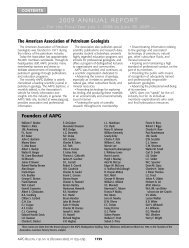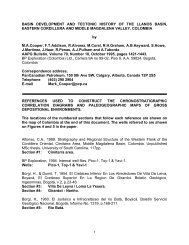AAPG Explorer - June 2010 - American Association of Petroleum ...
AAPG Explorer - June 2010 - American Association of Petroleum ...
AAPG Explorer - June 2010 - American Association of Petroleum ...
Create successful ePaper yourself
Turn your PDF publications into a flip-book with our unique Google optimized e-Paper software.
<strong>AAPG</strong><br />
EXPLORER<br />
WASHINGTONWATCH<br />
ARPA-E – Not a Typical Research Effort<br />
By DAVID CURTISS, GEO-DC Director<br />
It should come as no surprise that here at<br />
GEO-DC we spend a lot <strong>of</strong> time talking<br />
about energy and the future <strong>of</strong> energy. Our<br />
basic objective is to help people understand<br />
that oil and natural gas, which currently<br />
comprise nearly 65 percent <strong>of</strong> U.S. energy,<br />
provide the fuel and power needed for<br />
economic growth and jobs.<br />
But while fossil fuels are the foundation <strong>of</strong><br />
global energy – and will remain so for many<br />
decades, perhaps longer – we can expect<br />
alternative and renewable energy sources<br />
will continue to grow in importance. And it is<br />
possible that a scientist or inventor will make<br />
a technological breakthrough in coming years<br />
that transforms the energy sector.<br />
The Advanced Research Projects<br />
Agency – Energy (ARPA-E) is looking for that<br />
potentially “disruptive” energy technology.<br />
* * *<br />
ARPA-E was authorized as an agency<br />
within the U.S. Department <strong>of</strong> Energy in the<br />
America COMPETES Act <strong>of</strong> 2007. But, like<br />
many government programs, it was created<br />
and received no funding (see January<br />
Washington Watch) until passage <strong>of</strong> the<br />
<strong>American</strong> Recovery and Reinvestment Act <strong>of</strong><br />
2009.<br />
The stimulus bill provided $400 million to<br />
launch the agency, whose mission is “to fund<br />
projects that will develop transformational<br />
technologies that reduce America’s<br />
dependence on foreign energy imports;<br />
reduce U.S. energy-related emissions<br />
(including greenhouse gasses); improve<br />
CURTISS<br />
energy efficiency across all sectors <strong>of</strong> the U.S.<br />
economy and ensure that the U.S. maintains<br />
its leadership in developing and deploying<br />
advanced energy technologies.”<br />
But ARPA-E is not meant to be a typical<br />
government research effort.<br />
It’s modeled after DARPA, the Defense<br />
Advanced Research Projects Agency within<br />
the U.S. Department <strong>of</strong> Defense. DARPA was<br />
created in the late 1950s to respond to Soviet<br />
technical advances, such as the launch <strong>of</strong><br />
Sputnik, at the onset <strong>of</strong> the Cold War.<br />
According to Richard Van Atta <strong>of</strong> the<br />
Institute for Defense Analyses, DARPA has<br />
changed and evolved since its founding. It<br />
is a highly “agile” organization that is not risk<br />
averse, focused on “high-risk, high-reward”<br />
research. Its focus is “idea driven and<br />
outcome oriented.”<br />
DARPA’s investment strategies more<br />
closely resemble those <strong>of</strong> venture capitalists<br />
than traditional government R&D programs.<br />
And that is how Energy Secretary Steven<br />
Chu, himself a Nobel Prize-winning physicist,<br />
describes the goal <strong>of</strong> ARPA-E in funding highrisk,<br />
high-reward research.<br />
32 JUNE <strong>2010</strong> WWW.<strong>AAPG</strong>.ORG<br />
The benefit <strong>of</strong> ARPA-E funding over<br />
private capital at this stage is that they<br />
can focus on improving technology<br />
rather than raising additional money.<br />
Using a baseball analogy he says they’re<br />
asking scientists to swing from the heels.<br />
Some will strike out. But other scientists will hit<br />
home runs and some will hit grand slams.<br />
The research portfolio is broad. Program<br />
topics that ARPA-E is funding range from<br />
conventional energy and carbon capture to<br />
vehicle technologies and biomass energy.<br />
There have been two funding rounds since<br />
the agency launched. The first encompassed<br />
many forms <strong>of</strong> energy; the second is more<br />
focused. Competition in round one was fierce,<br />
with only 1 percent <strong>of</strong> proposals submitted<br />
selected for funding.<br />
Affordable Power From Water and Sunlight<br />
is the title <strong>of</strong> one funded project being<br />
conducted by Sun Catalytix Corporation.<br />
The firm is using sunlight and a catalyst<br />
discovered at the Massachusetts Institute <strong>of</strong><br />
Technology to separate hydrogen and oxygen<br />
from either tap water or clean seawater. The<br />
science is proven. But ARPA-E funding will<br />
enable them to improve performance and<br />
develop prototype devices with an eye on<br />
commercial deployment.<br />
If successful, the project will deliver an<br />
David Curtiss, head <strong>of</strong> <strong>AAPG</strong>’s Geoscience and Energy<br />
Office in Washington, D.C., can be contacted at dcurtiss@<br />
aapg.org; or by telephone at 1-202-684-8225.<br />
affordable renewable energy storage device<br />
that could be used in both <strong>of</strong>f-grid and on-grid<br />
installations.<br />
Sunlight and the catalyst split water<br />
molecules into hydrogen and oxygen suitable<br />
for use in a fuel cell to generate electricity. It<br />
is an elegant way to “store” solar energy – if it<br />
works as intended and can be deployed as<br />
cheaply as expected.<br />
* * *<br />
But the path <strong>of</strong> any new technology<br />
is typically bumpy, leading through the<br />
dreaded “valley <strong>of</strong> death,” as it tries to move<br />
from successful lab bench prototype to<br />
commercially viable product. The benefit <strong>of</strong><br />
ARPA-E funding over private capital at this<br />
stage, according to Sun Catalytix, is that they<br />
can focus on improving technology rather<br />
than raising additional money.<br />
“Our nation’s history is replete with<br />
examples <strong>of</strong> pioneers and entrepreneurs<br />
who took risks, said ARPA-E Director Arun<br />
Majumdar. “These innovators <strong>of</strong>ten failed<br />
initially, but quickly learned from those failures,<br />
competed against each other and innovated<br />
in both technology and business to create<br />
the largest industrial base the world has ever<br />
seen.<br />
“ARPA-E’s goal is to tap into this truly<br />
<strong>American</strong> ethos, and to identify and support<br />
the pioneers <strong>of</strong> the future.”<br />
ARPA-E is engaged in a daring enterprise,<br />
and more information about the funded<br />
projects is available on the agency website<br />
(http://arpa-e.energy.gov). EXPLORER















